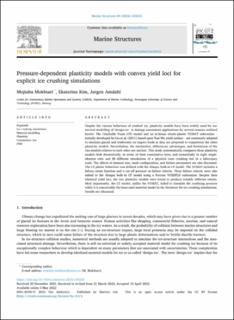| dc.contributor.author | Mokhtari, Mojtaba | |
| dc.contributor.author | Kim, Ekaterina | |
| dc.contributor.author | Amdahl, Jørgen | |
| dc.date.accessioned | 2022-05-10T12:18:32Z | |
| dc.date.available | 2022-05-10T12:18:32Z | |
| dc.date.created | 2022-05-05T18:27:38Z | |
| dc.date.issued | 2022 | |
| dc.identifier.citation | Marine Structures. 2022, 84 103233-?. | en_US |
| dc.identifier.issn | 0951-8339 | |
| dc.identifier.uri | https://hdl.handle.net/11250/2995090 | |
| dc.description.abstract | Despite the viscous behaviour of crushed ice, plasticity models have been widely used for numerical modelling of ‘design-ice’ in damage assessment applications for several reasons outlined herein. The Crushable Foam (CF) model and an in-house elastic-plastic VUMAT subroutine – initially developed by Liu et al. (2011) based upon Tsai-Wu yield surface – are commonly adopted to simulate glacial and freshwater ice impact loads as they are proposed to outperform the other plasticity models. Nevertheless, the similarities, differences, advantages, and limitations of the two models relative to each other are unclear. This study systematically compares these plasticity models both theoretically, in terms of their constitutive laws, and numerically in eight single-element tests and 28 different simulations of a physical cone crushing test in a laboratory scale. The effects of element size, mesh configuration, and failure parameters are also discussed. The CF plastic behaviour was defined with the Abaqus built-in CF model. The VUMAT includes a failure strain function and a cut-off pressure as failure criteria. These failure criteria were also added to the Abaqus built-in CF model using a Fortran VUSDFLD subroutine. Despite their identical yield loci, the two plasticity models were found to produce notably different results. Most importantly, the CF model, unlike the VUMAT, failed to simulate the confining pressure while it is conceivably the most used material model in the literature for ice crushing simulations. Details are discussed. | en_US |
| dc.language.iso | eng | en_US |
| dc.publisher | Elsevier | en_US |
| dc.rights | Navngivelse 4.0 Internasjonal | * |
| dc.rights.uri | http://creativecommons.org/licenses/by/4.0/deed.no | * |
| dc.title | Pressure-dependent plasticity models with convex yield loci for explicit ice crushing simulations | en_US |
| dc.title.alternative | Pressure-dependent plasticity models with convex yield loci for explicit ice crushing simulations | en_US |
| dc.type | Peer reviewed | en_US |
| dc.type | Journal article | en_US |
| dc.description.version | publishedVersion | en_US |
| dc.source.pagenumber | 103233-? | en_US |
| dc.source.volume | 84 | en_US |
| dc.source.journal | Marine Structures | en_US |
| dc.identifier.doi | https://doi.org/10.1016/j.marstruc.2022.103233 | |
| dc.identifier.cristin | 2021931 | |
| cristin.ispublished | true | |
| cristin.fulltext | original | |
| cristin.qualitycode | 2 | |

